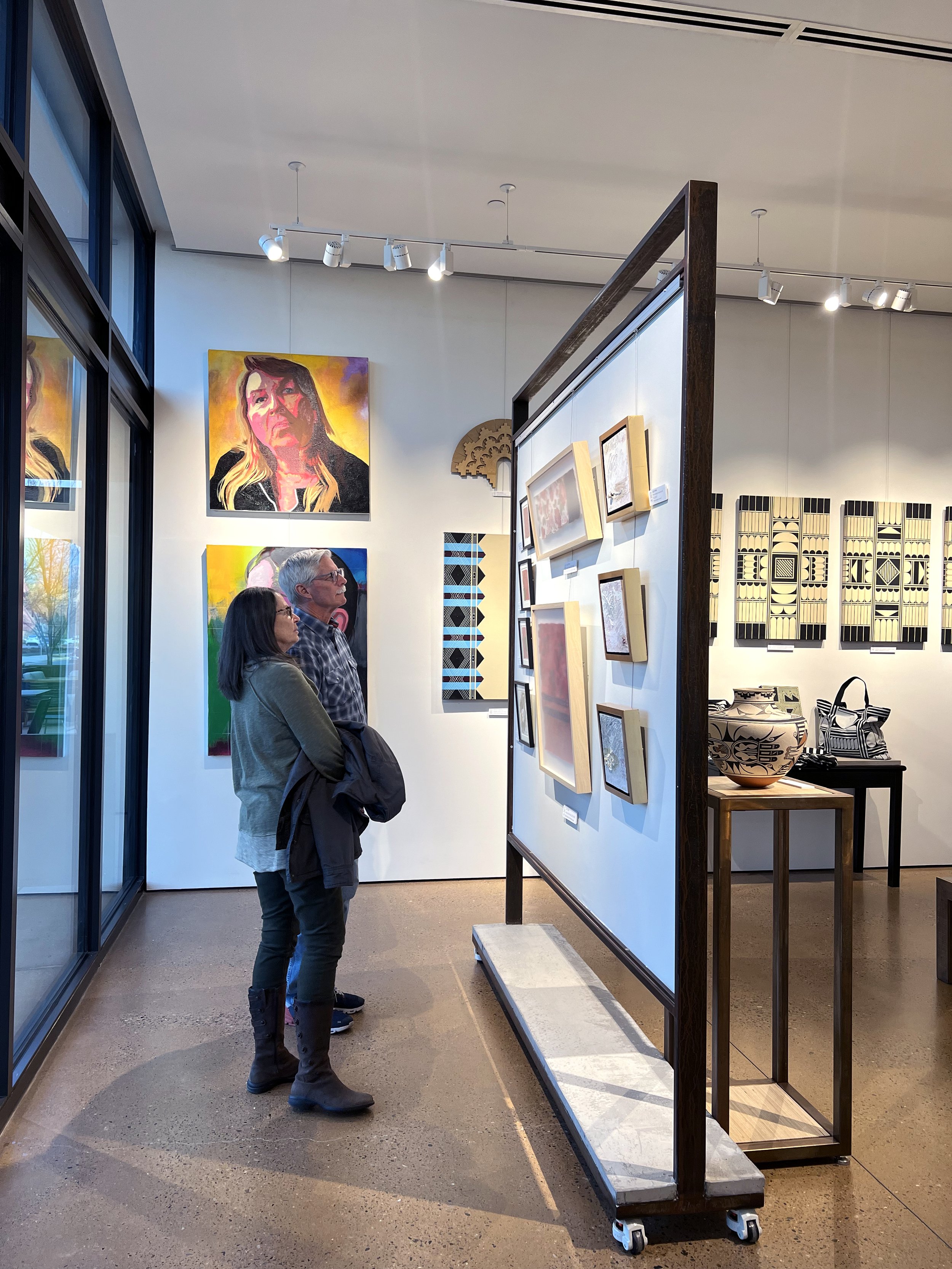Pottery as Prayer: Jacob T. Frye and David Naranjo in InBetween Lands
Of all the art forms produced across the Southwest, fired ceramics are arguably the most ubiquitous media. Found in every ancient site and in every contemporary Pueblo in New Mexico, pottery and pot sherds last for several millennia so the shapes and painted designs offer a visual history of the area. Since the clay from each area has unique colors and properties, a piece of pottery contains information about its origins. For example, clay from northern New Mexico often has micaceous flecks and fires to an orange-brown, lending itself to unpainted wares. Clay from the area around Acoma and Laguna is a pure white and can be used to make a thin walled vessel, which is often decorated with fine black lines for contrast.
On the painted pieces, designs reflect what is important to life in the desert -- namely, continued rain for continued life. Images of clouds, falling rain, birds, feathers, plant life, corn fields, rain birds, frogs, water bugs, and other natural features associated with water dominate the designs. When seen together, these images form a visual language articulating the artist’s prayers for life. Featuring the pottery of Jacob T. Frye and the paintings of David Naranjo, InBetween Lands highlights the importance of imagery in the Southwest as a prayer for water and the continuation of life in the world.
Jacob T. Frye learned pottery from his mother and his grandmother at Tesuque Pueblo, learning to hand form a vessel when he was five. Both of his parents are artists and they instilled his love of artistic processes. For InBetween Lands, Jacob created a series of four pots, or ollas as they are often called, to reflect the history of ceramics across the Pueblos, historic and contemporary, influenced by Matte black-on-polished black by Maria Martinez from San Ildefonso, Sikyatki-style by the Hopi potter Nampeyo, and late nineteenth-century shapes. He seeks out museum collections and archives to study the shapes and designs, exploring and pushing the boundaries of what is possible. These pots reflect historic forms, yet the energy he gives the vessels brings fresh life to the pieces.
Though he usually collects his own clay, these four were made with commercial clay, easier to access during the winter when the ground is frozen. He mixes a slip for his pottery using the shavings from sanding the pot then uses the bits that come off, mixed with water as a slip to seal the vessel. When he gathers his own clay, he ground fires the pieces while the commercial clays are fired in a kiln. Whether he is working with commercial clay or clay he gathered, Jacob hand formed all of his pottery. This series demonstrates the artist’s abilities to create beautiful dramatic shapes.
For Jacob, pottery represents the universe as it comes together, not just for him but for the whole world. The painted elements on the pot all suggest prayers for rain and life, including the swirled line for a cloud painted in all four directions as a prayer for rain, feathers painted around the neck, rainbirds around the body, lightning bolts, hatched lines for rain, and cornfields in the checkerboard patterns. Jacob added a few touches of Cochiti red clay to his pots that he dug from La Bajada Hill just south of Santa Fe. Jacob observed that the combination of red, black, and white/cream found in much of the pottery from the Southwest is often found in nature. The Cochiti red clay across the bottom represents water coming from the earth. The thick red band around the middle served to keep the rivers full, always important in the Southwest. Two of the pots in the series include dots, which the artist explained indicate that the pot is alive. Jacob demonstrates his ability to recreate historic shapes and designs, imbuing them with fresh life and energy.
Like Jacob, David Naranjo’s work highlights the symbolism found on the ceramics, which he translated into two-dimensions. Enrolled at Santa Clara, San Juan, and Cochiti Pueblos, he received his BFA from the Institute of American Indian Arts where he studied with Plains Cree painter Jeff Kahm. Kahm’s hard-edge abstraction, inspired by designs from parfleches and other Plains designs, have influenced students, whose paintings have the clean lines and visual impact of David’s paintings.
David’ paintings articulate visual prayers similar to the designs on Pueblo pottery. He notes, “I don’t see my paintings as “art” but rather visual prayers and my personal way of connecting to the divine.” He represents his Tewa/Keres and Spanish background, allowing the different cultural ties to work together. He was inspired by Museum of Indian Arts and Culture curator Tony Chaverria, who noted “The painter, the potter and makers; decorations aren’t just for artistic flourish but echoes their home, their place in the universe. It’s in this space where the SEEN and UNSEEN exists TOGETHER”
For Inbetween Lands, David looked to designs on pottery, such as clouds, rain, plants, feathers, and bird forms, painted with both commercial and natural sources. In his triptych Majestic Birds, David adds mineral pigments to the surface, similar to applying slip to a piece of pottery. With cloud forms, checkerboard patterns, and rain lines, these paintings embody the prayers so important in the high desert. David’s compositions suggest the underlying order, as seen in the design of Requiem with its radial symmetry. The designs are based on feather forms from Mimbres pottery, which were used in the pottery of Maria Martinez. The complex relationship between background and foreground suggests the ties between the physical and spiritual worlds.
Seen together, the works of Jacob T. Frye and David Naranjo suggest the long ties to historic designs, which maintain their importance and relevance as prayers for continued life in the Southwest. With their symmetries and use of locally found materials, the pieces in InBetween Lands share their hopes for a continued life.















